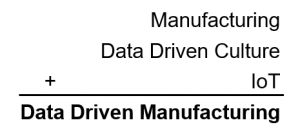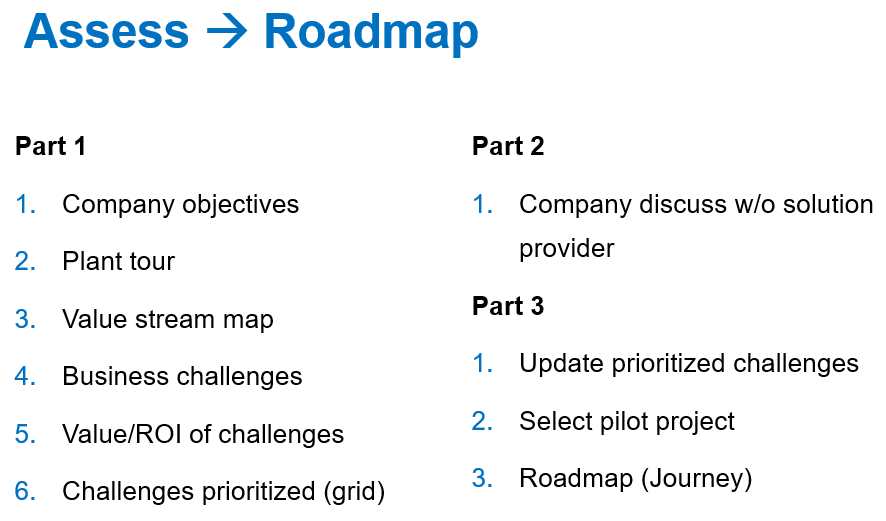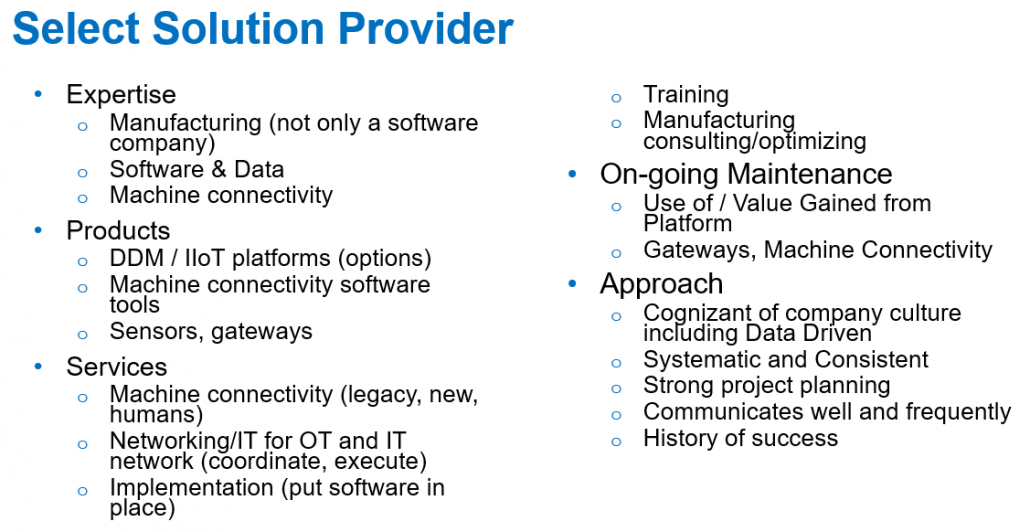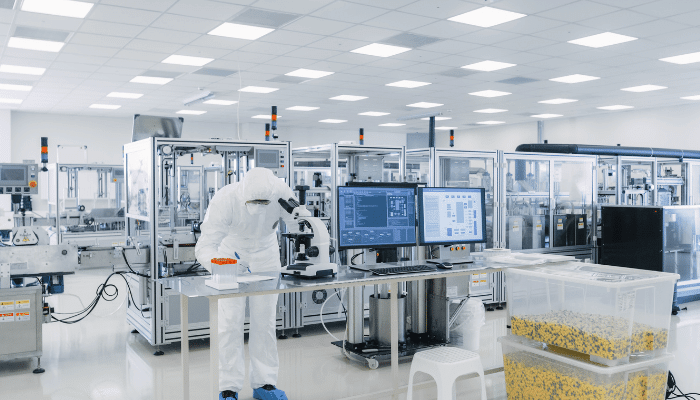Are you worried or concerned at all about the IIoT project you’re about to launch? Or maybe you’re considering an IIoT / Data-Driven Manufacturing project and hesitant due to the horror stories in the “press”?
I hear you on those concerns and worries. It can be daunting to put a new tool in place to do things data that your company may not have done before…that being to pull data from machines and operators and provide real-time visibility to the plant floor, have data to find and eliminate inefficiencies, and increase production capacity and throughput.
Data-Driven Manufacturing Definition
Before I go much further it’d be good to be sure we get on the same page about what Data-Driven Manufacturing is. I’ll do this really quickly.
Firstly, I use the phrase Data-Driven Manufacturing interchangeably with IIoT (Industrial Internet of Things) and Manufacturing Analytics. There is a whole semantics discussion in there…what I often refer to as a “2 beer” conversation…yes, I measure my conversations in the number of beers). However, we’re going to skip that semantic discussion today.

- Manufacturing
- Data-Driven Culture
- IoT
IoT is pulling data from devices and sensors on machines, making that data valuable, and getting that new information in front of the right people to use for making decisions and taking valuable action.
Being Data Driven means that all of the people in that company that require it have access to the right data, can use that data to make decisions, and most importantly are empowered to take valuable action based on that data….typically corrective or Continuous Improvement actions.
Having a Data-Driven culture at your manufacturing company is really important. Some companies may not be prepared to take on a Data-Driven Manufacturing solution because they lack a Data-Driven culture. People need to be open to change, improving operations, and using data to do it. At some companies that isn’t the case. In those cases you’ll often hear, “We’ve been doing it this way for the past 30 years…” and on and on.
However, this shouldn’t be a huge stage gate in the process of implementing Data-Driven Manufacturing. A lot of companies are already using data in their Continuous Improvement projects, gathering Lean data, having daily production meetings. So, they’re already using data. Data-Driven Manufacturing simply takes them a couple of steps further…it’s not a leap light years into the future. Data-Driven Manufacturing simply provides more accurate, additional valuable, and real-time information to use in the existing normal processes of daily production meetings, Lean, Continuous Improvement, etc. Once the Data-Driven Manufacturing solution is in place and used in some of the existing processes and once it’s proven to be really valuable, then the manufacturer can move to expand the Data-Driven Manufacturing solution across more machines, lines, and plants.
With the definition of Data-Driven Manufacturing covered, and a little extra flavor for how it can fit into a business, let’s talk about the Journey.
Data-Driven Manufacturing Journey
Data-Driven Manufacturing can be viewed as a journey. That Journey can be broken into 5 steps.
- Prepare – Manufacturer gains an understanding of that Data-Driven Manufacturing is, how it can be used realistically within their company, and the positive impact it can bring.
- Connect – Make sure the machines used in production, regardless of age, can be connected and are sharing their data on a network.
- Visualize – Manufacturer can view and shares real-time, analyzed information across the organization to drive improvements.
- Analyze – Manufacturer establishes KPIs to measure performance and find areas for improvement.
- Optimize – The business is making decisions based on the analyzed information to improve efficiencies, production, and profits.
Journey: Step 1 – Preparation
The Preparation step is a critical step to achieve success in putting good Data-Driven Manufacturing solutions in place. If you’re working on a project that has more than a few steps, more than a couple of people involved, and more than a couple of machines or data points or other pieces of the project puzzle, you need to plan it out to ensure optimal success. Well, that’s what this step of the Journey is about.
There are 4 stages to the Preparation stage. I’ll address each stage separately below.
- Select Solution Provider
- Establish Expectations
- Assess –> Roadmap
- Plan Pilot Project
Select Solution Provider
The first part is selecting the best possible solution provider to ensure success and very large returns on their investments in Data-Driven Manufacturing.
The IIoT / Data-Driven solutions providers that can execute the best are the ones that have a large set of capabilities within this narrow space and experience. The alternative is to work with multiple companies and coordinate all of their efforts, i.e., you become the general contractor…not a fun job if you’re not prepared for it. Working with a single solution provider can give you the one point of contact or better yet throat to choke to get the project done.
Here is a list of capabilities solution providers should have. This list is extensive and can substantially whittle down the list of prospective solution providers to consider. You will find there are technology providers (e.g., companies that have an IIoT platform, or IIoT gateway devices) who will try to provide a solution. However, when the manufacturer asks for them to connect to the machines to pull the data, or to customize this or that in the platform the manufacturers get blank stares. The full solutions providers, we could also call then Systems Integrations (like us, Ectobox) can provide the full set of services to ensure a solid setup.
Something else to keep in mind is this list can be used to create your own checklist for evaluating solution providers.
Establish Expectations
Once a Data-Driven Manufacturing / IIoT solution provider is selected they should immediately start with helping the manufacturer become comfortable with:
- Challenges: Understand plant floor challenges and plans, set context
- Knowledge: Data-Driven Manufacturing
- Art of the Possible: What’s possible, be realistic, no special terminology
- Culture: Understand the Culture of People and Data-Driven
This helps set the table, makes sure everyone is on the same page about where the manufacturer could go within the context of their current setup and their future plans.
A good point to make here is how important the cultural side of that equation is to the success of the project.
For example, let’s say you put a solution in place to give operators data to see their actual production with the hope they’ll look for ways to increase production. Let’s also assume those operators the type that wants to continue doing it the way they’ve done it for 20 or 30 years. If they’re not ready to change what they do and how then Data-Driven Manufacturing could fail.
On the other hand, if you’re already having daily production meetings, writing data on log sheets and spreadsheets, and using that data for the current, limited visibility in the plant…then transitioning to Data-Driven Manufacturing isn’t as big of a transition as you might think. It’s simply a matter of putting some technology in place to get more timely, more accurate, and new valuable data from your plant floor, and then starting to use that data in your existing processes. Then you can expand from there.
Truthfully, I’m oversimplifying a bit. I don’t mean to sweep various complexities under the rug. There are some technical challenges to putting the projects in place. However, this is not rocket science here. Success is possible with appropriate planning.
Assess, Roadmap
The next stage in the Prepare step of the Data-Driven Manufacturing Journey is to assess the current stage and work towards creating a roadmap for implementing and using Data-Driven Manufacturing across the plant.
This is the stage where the solution provider and the manufacturer get together, in-person if at all possible, in a workshop format.
The objectives of this step are:
- Understand the company and its goals, the culture around people and being Data-Driven, the manufacturing operations, challenges, and priorities
- Develop a roadmap for implementing Data-Driven Manufacturing that fits the company’s current and future needs
- Find the least expensive, most impactful application of Data-Driven Manufacturing which then becomes the candidate for the pilot project
- Set the foundation for expanding and scaling the DDM solution over time
There’s a process for achieving these objects. The process is laid out in the image below in 3 parts.
- Part 1 – Go through each of the items in the list. These discussions are lead by a manufacturing expert in-residence at the solution provider. The result is the quadrant or grid diagram with the manufacturer’s challenges laid out. The items at the top right of the diagram will be the challenges that are least complex to solve and most valuable to solve. Again, those are the candidates for the pilot project.
- Part 2 – This is an opportunity for the manufacturer to step back, and on their own assessment if they agree with what the solution provider came up with. Are those challenges correct, are we ready, do we really need this solution, does that proposed pilot project make sense.
- Part 3 – Both parties reconvene, discuss the results of the manufacturer’s work, settle on the appropriate pilot project, and finalize a roadmap for when and how other challenges might be addressed over time.

- Develop a roadmap for implementing Data-Driven Manufacturing that fits the company’s current and future needs
- Find the least expensive, most impactful application of Data-Driven Manufacturing which then becomes the pilot project, the first project
- Set the foundation for expanding and scaling the Data-Driven Manufacturing solution over time
Plan Pilot Project
The next stage in the Prepare step is to Plan.
The purpose of this stage in the Journey is to:
- Setup everyone for success on the pilot project,
- Ensure the pilot is ready to be scalable for long term expansion and return on investment
This process outlined here is really important. It’s something I’ve found missing in some companies all too often. We have seen multi-billion dollar companies get wrapped around the axle starting with the sensors and pulling as much data as they can. They don’t have any goal or focus or business challenge to solve. They’re trying to do IoT for the sake of doing IoT.
A better process is to, again, have a process. This process is pretty straightforward when you think about it…maybe even a bit obvious:
- Business Challenge – Clearly define “on paper” the challenge you’re trying to solve in the pilot project. Maybe it’s significant unplanned downtime on a critical machine which is a bottleneck in your production and limits total revenue generated by the plant.
- Business Case with Hypothesis – Create a business case around that business case and a hypothesis, and the idea of what you believe you can accomplish. Based on certain data you have on your machine, you might say “We can reduce downtime by 15% and get all follow-on machines fully productive, and by doing so (based on calculations in your spreadsheet) you can increase plant revenue by $300K/year.
- Information – Consider what analyzed information, what charts, what visualizations you’ll need to use in tackling the business challenge and proving the hypothesis. What will you need to address unplanned downtown? Maybe a Pareto chart of downtime with reason codes by total time and separately another similar chart by a number of occurrences.
- Data – Define the limited set of data points (i.e., machine tags) that needs to be pulled from the machine, data entry into a tablet required from an operator, or fields of data from an outside source like an ERP system. These should be limited to only the data points required to generate the analyzed information above.
- Technology – Define the required technology to provide the data points above, such as types and placement of sensors, IoT gateways, machine connectivity software, etc.
This process ensures you stay focused on solving only the business challenge at hand and prevents the team from getting wrapped around the axle with sensors and data tags.
Once this process is complete, you’ll eventually get to implement it. That is a straightforward process there, where you’re going back up that list, implementing the technology first, which provides the data, which is then translated into valuable information in the form of data analytics and visualizations, etc.
Are We Ready to Start?
Once all of this work is complete and agreed upon the solution provider should be using a checklist to confirm everything is ready. We have an internal Data-Driven Manufacturing maturity model and from that, we have derived a Data-Driven Manufacturing Project Readiness checklist.
This is a simple part of the process of being thorough. Of course, we don’t want to over-plan…again, this isn’t rocket science, we’re not literally sending astronauts into space. At the same time, we don’t want to throw caution to the wind. So, we try to do what I call getting into the Goldilocks Zone…not too complicated, not too simple, we’re looking for just the right amount of planning for the level of complexity. It helps to have some project management experts in-house (i.e., PMP’s).
With all of that done then a company should be ready to execute their project with a very good chance of success and return on investment.
If you’re considering an IIoT or Data-Driven Manufacturing project to get visibility onto your plant floor and are concerned about the potential for success, call me and let’s talk.
If you’re interested in keeping in touch via our weekly newsletter, please sign-up here…we’d love to have you join the conversation.
Ready to get started?
Let’s do this!







